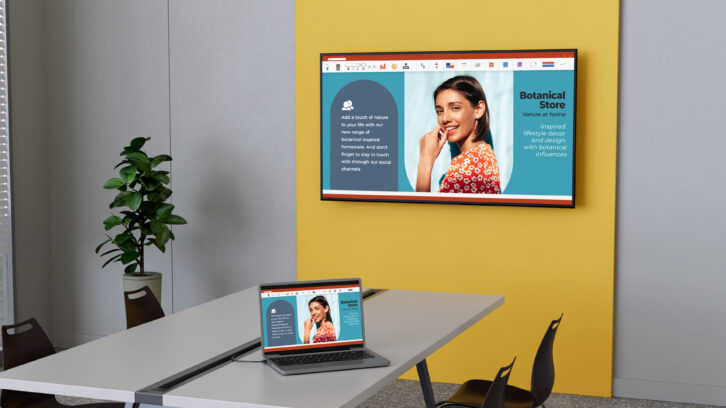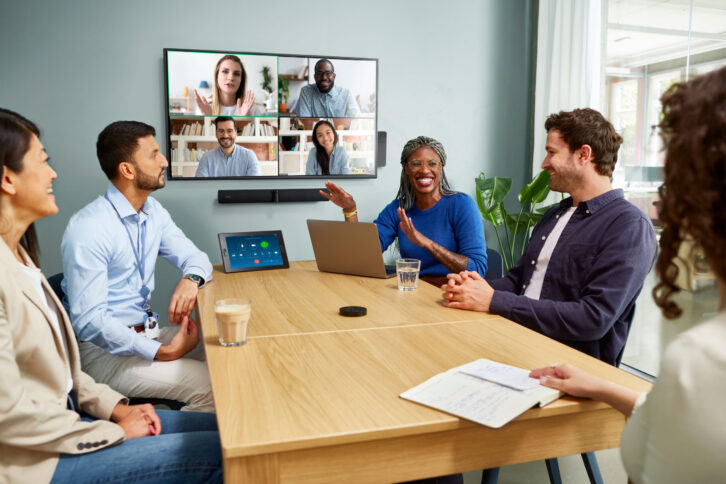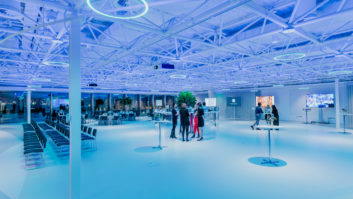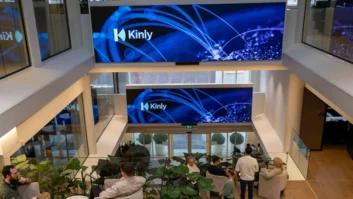The world of corporate AV has been in a state of flux ever since the global pandemic, as a new world of work takes shape and a bludgeoned global economy sputters into life. Companies know they have to spend on AV, often to replace inadequate equipment purchased hastily during lockdowns, or outdated tech obtained even earlier. Deciding precisely when, and what, to buy is more open to debate. The impression is of a market poised to surge, but at times still hesitant when confronted with complex new realities, expiring leases and a huge range of tech options.
A recent survey from Kinly revealed the urgent AV spending priorities facing many companies. It showed 41% of enterprises needed to upgrade AV bought during the pandemic, and nearly half of the 425 enterprise AV professionals working in the UK, Germany, Nordics, and the Netherlands (46%) were planning to replace outdated AV bought before the pandemic. The report indicated a widespread resolve towards modernising AV infrastructure to meet the evolving demands of the modern-day workplace.

Alistair Johnston, head of collaboration, Futuresource Consulting, says AV procurers are starting to feel optimistic about budgets after an unexpected slowdown in 2023. “They’re expecting budgets to rise, and that’s positive. There’s an acknowledgement that in the medium- to long-term there’s going to be more spending, but often they don’t want to do it today. They want to make sure the economy gets better, or until they move to a new office and they’re sure about hybrid working patterns,” he says.
EXPIRING LEASES
Another reason to stall spending, he says, is when enterprises have taken out a lease that expires in the next couple of years. “The plan is to wait until it runs out, before investing in tech for a different, more modern, smaller space. That’s a common finding in our surveys. We’re also finding that working patterns are stabilising and, if anything, we expect a move to even fewer people in the office,” Johnston adds.
Peter Hansen, chief economist, AVIXA, is slightly more upbeat than Johnston about seeing more corporate investment globally immediately. He believes the corporate world has started to spend more again in 2024. “Two factors are spurring the spending: First, we’re getting to the refresh cycle of some of the early-pandemic buildout. Second, businesses are growing in confidence about their long-term needs. Businesses were very uncertain during the early struggles to bring workers back to offices in 2022 and 2023. But that has changed. They know they have long-term needs for their offices, so they’re spending accordingly. Of course, confidence has a long way to go in terms of total amount, solution mix, technology stack, etc. But we’ve seen major increases and a commensurate increase in spend.”
Despite his optimism, Hansen echoes Johnston in commenting on the hesitancy of many enterprises in making long-term commitments. “Businesses are feeling more comfortable with the balance of in-person and remote, but they’re still puzzling over the number of conference rooms that are needed, the size of those rooms, and what level of AV they need in them. It’s less about ‘looking to invest’ and more ‘trying to get it right’,” he observes.
Hansen insists the AV community should not misconstrue his comments as implying that businesses aren’t interested in innovation. “Businesses know they have new problems and need new solutions. It’s just the range of possibilities is so wide that it’s less about splitting hairs to find the perfect tech than it usually is. Businesses now are focused less on perfect technology and more on the basic alignment between technology and needs,” he argues.

Whether companies spend in the short-term, or medium- to long-term, the question still remains of what AV to select from the bewildering array. Certain trends have emerged, such as the ubiquity of videobars, the growing popularity of LED, and the increasing importance of high-quality audio, once a neglected area of AV for enterprises. There has been a massive uptake in Microsoft Teams and a lot of businesses are now on an Office 365 subscription. Meanwhile, a growing number of companies are attracted to more environmental solutions, such as the new sustainable ePaper screens. And more and more companies are cloud-based.
Nevertheless, taking long-term decisions about precise requirements has never been harder. Standardisation of set-ups would help companies to simplify decision-making and reduce training demands. But some flexibility is necessary in a fast-changing world and standardisation remains a distant dream for most. Johnston comments: “One of the things holding back growth is a lack of best practices, or standards. What should rooms look like? Or what does a standard package look like? There are lots of competing solutions. One manufacturer does it this way and another does it that way. Although Microsoft is trying to bring that all together, you need to have a Microsoft Team’s Room, which means you will have a subscription and an approved list of manufacturers you can buy from.”
INTEGRATOR POWER
For companies investing in more sophisticated meeting room set-ups, the role of integrators has become more critical than ever. In a podcast, AVIXA’s Sean Wargo, VP, market intelligence, said a large percentage of enterprise meeting rooms still lack essential equipment for modern working. Many are not video-enabled, for example. This is where, for some companies, integrators can help to develop more efficient, customised approaches.
“As integrators become more familiar with the tools and the platforms, and also as new features and products roll out, their palette of paints keeps increasing,” comments Wargo. “Each hardware option and each design template adds to the set of paints you can use to develop a solution. It becomes possible to accommodate visual needs, business models, the amount of hybrid solutions required, workflows and spaces in the offices. So all of that is creating an opportunity for that customised approach, which is where we get to the sweet spot for integration.”
More innovation in the field of enterprise AV is beginning to emerge too, adding to the integrators’ bag of tricks, according to Alistair Johnston. He says that during the pandemic, research spending stagnated, which put the brakes on innovation. For a long time, the sector saw only evolutions of existing technologies, most of which predated the pandemic. But research budgets have bounced back. The most striking recent example of a new development, he believes, is multi-camera systems.

“It’s yet to take off, but it’s a new approach,” says Johnston. “You could either have a video bar and a PTZ camera, or some combination, as a speaker tracking camera. One really interesting model is the 360-degree table-top camera, with the videobar. Examples include Logitech Sight, Neat Centre and Poly Studio E360. They offer a combination of vision from the end of the room, as well as a camera in the middle which picks out faces and automatically chooses the best view for the person who’s working remotely, depending on where they’re looking. So if they’re looking towards the display, you see that view and if they’re looking across the table, you will see that.”
JURY OUT
Despite being impressed with the innovation, Johnston argues that “the jury is still out” on whether a lot of companies will be prepared to invest in the tech. “It’s still quite an expensive way of doing it because you still need a videobar, and you still need a Zoom Room or an MTR. And those cameras are around $2,000. So you’re possibly looking at a JP Morgan, or a Barclays Bank, who would be willing to invest in such a set-up,” he explains.
Faced with the complexity and the high costs, he says plenty of enterprises are likely to take an easier route. “They ask the question, ‘why would I buy all that when I can just plug my laptop into the cable to a videobar, or a camera, and then I don’t need a subscription and I’d open all my contacts on my laptop and it’s really easy for me to share content. It’s flexible. I can do a Zoom call if I want to, or a WebEx call if I want to’. For lots of companies and lots of users, that’s just fine.”
Johnston is also sceptical of the value of meeting rooms for a lot of enterprise workers. Most video conferencing is between individuals, or a handful of people with cameras in front of them, he says. It’s easy to bring up a shared screen and the video quality is good enough. “Then you go into a meeting room and make a call and it can be terrible by comparison,” he adds. “We know from our surveys that lots of people prefer to sit at their desks and make a call rather than going into a meeting room, even if colleagues are doing that. A worker might find it easier to just put on headphones at their desk, be able to see the content and share information easily. It’s not that pleasant going into a room and a display with someone else going remote as it just becomes quite complicated.”
Rather than suggesting enterprises will not purchase AV, Johnston is implying they will weigh up if they really require a piece of equipment, given the high costs, or can make do with simpler options. Futuresource’s research from 2024 is clear: all enterprises are considering what AV they will need in the era of remote working and online communication. For example, the 2024 Futuresource Hybrid Work Survey of 3,200 tech end-users from the US, UK, France, Germany, India and Japan, confirmed what most people already suspected: by the end of 2023, just under half of employees were fully office based (46%), 39% were hybrid workers and 15% were either fully remote or fully flexible.

Another 2024 Futuresource survey offered more Insights into how enterprise decision-makers are reacting to changes in working habits, especially hybrid working. In the AV Decision-Maker Survey of 900 tech decision-makers, from those same six countries, nearly three quarters reported changes to office design as a result of the pandemic. The most common responses were an increase in collaborative spaces and breakout areas (29%) and an increase in meeting rooms (21%).
SOFTWARE INNOVATION
At AVIXA, Peter Hansen says a lasting legacy of the pandemic is the rise of all-in-one solutions, where manufacturers – Yamaha is a notable example – offer a catch-all audio and video-conferencing solution that is easy to manage, and performs consistently. However, Hansen believes the most significant innovation has been in room layouts and, especially, software. “The software playing field has changed dramatically, with new capabilities, further integration with hardware, and now the rise of AI,” he comments.
Software developers are responsible for the biggest change over the past year, he says. The rise of AI in video-conferencing software, could be a gamechanger. “As for many applications of AI, there’s more potential than actual use yet. But usage should increase as users learn how to leverage it. This could evolve into in-person only meetings,” Hansen believes.
“Hardware solutions are much simpler due to the software enhancements that cover up technical issues. The take-up here is high. For general-purpose AI such as LLMs, the take-up is lower. But general-purpose AI like Microsoft’s Copilot could have a profound impact on pro AV if all meetings are added in a videoconferencing platform in order to have the AI recording.”
Hansen makes a final prediction around the rise of platform-based rooms, which will prove challenging for all parties to adjust to. “Manufacturers are going to have to think carefully about how they slot into an ecosystem: What their identity is, what they sell on, what stakeholders they need to court to drive revenue,” he says. “Distributors will have to think about the opportunities available for serving these rooms, and threats to their value proposition if product selection shifts to ecosystem approval from many product experts. Integrators will have their own suite of questions to consider: how they focus on volume vs value, how they support ongoing software upgrades, and how they serve end users that are potentially more IT-centric.”
For his final comment, Johnston says whilst it may be likely innovative technology shown at ISE and InfoComm will prove popular among larger, wealthier multinationals, take-up from SMEs is less likely. “Pretty much all the attention at the large trade shows is around the high-end niche. But there’s a huge other space of SMEs, and countries with less dynamic economies, that are less interested. Mostly, they’re quite happy plugging a cable into a laptop,” he concludes.
This article features in our special Enterprise AV eBook. Please click here to sign-up for access; it only takes a few seconds! Meanwhile, see below for enterprise AV design insight…
–––––––––––––––––––––––––––––––––––––––––––––––––––––
TECH & DESIGN IN ENTERPRISE SPACES
Louise Curnuck, designer and leader in creative direction for the built environment, discusses how AV tech is continuing to inform office design, post-Covid

The workplace has experienced a revolution. The birth of WeWork in 2010, and the co-work model, has forced companies to up their game in terms of the environments they offer their employees. The grey carpet tile, badly lit, row after row of desks, has thankfully had its day. The aftermath of Covid created a second wave to this revolution, with companies trying to entice people back into the office with wellness front and centre – and it has been proven that providing an enjoyable and agile workplace boosts productivity.
AV and tech in general have a huge part to play in our experience of place. When it works well, we barely notice it, when it doesn’t it can cause stress. Using AV in creative ways in the workplace can create novel experiences that subconsciously improve one’s mood, or provide memorable experiences. I started my career in an office with a virtually-projected receptionist who directed visitors to lifts where lit, ‘press-me’ buttons played sound bites from songs, or famous lines from films. This simple but very effective whimsical experience was never forgotten by anyone, and corporate guests would rush back to tell their colleagues.
Access to different AV communication tech in specially designed spaces, where the lighting and acoustics can make an online meeting more efficient and flattering; and places where sound and light can provide relaxation for time out from stressful situations, or provide reassurance when a difficult decision has to be made: these are other ways of making the workplace more attractive to employees.
AV has a fantastic ability to completely convert a space for different experiences too – from office to social event space at the flick of a switch, or providing theatre for townhall presentations to keep employees engaged and inspired. AV-packed client hospitality spaces and so-called marketing suites continue to grow in popularity, allowing in-house teams and clients to collaborate using the latest tech.
As well as collaboration and wellness, the opportunity to socialise is ultimately the key in encouraging team members back to the office, so anything AV can do to create human-centric places, through well thought out, considered design, can only benefit enterprise and the workplace.
Louise has worked on the renovation of global head offices, helped create co-working brands, and consulted at one of London’s leading workplace design and build firms.
This article features in our special Enterprise AV eBook. Please click here to sign-up for access; it only takes a few seconds!






